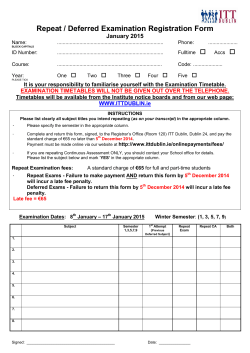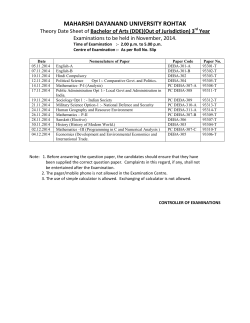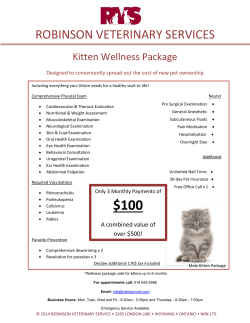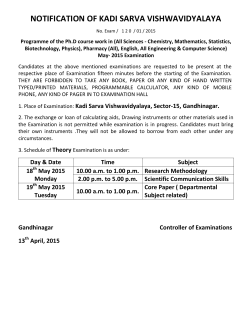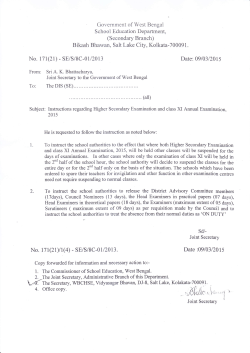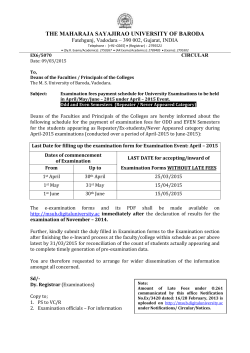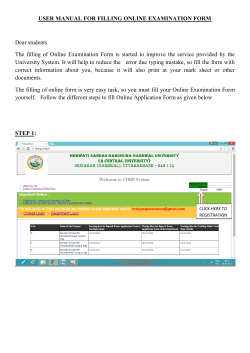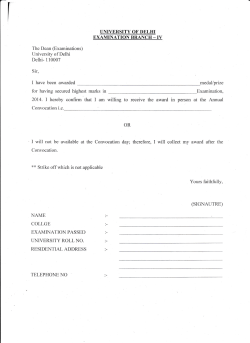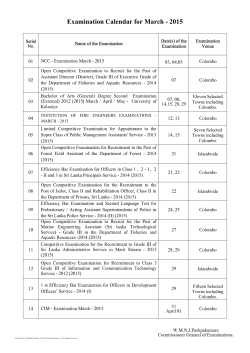
SITE FOR A LOCAL COMMUNITY
SITE FOR A LOCAL COMMUNITY Cphbusiness 2014/15 3rd Semester 3rd test Introduction Project requirements With the current media development more and more people feel themselves disconnected from what is happening in their local area. Newspapers and other media have gone global and only a few is covering the local stories and debates. Project formulation A firebrand (ildsjæl) has donated a sum to develop a website where you can keep informed about what is happening in an area and take an active part in debates, social work and the like. Here one could have discussions about different subjects, selling, giveaways or agree a common neighborhood party. It could be about cultural events, communal or voluntary work, which could be disseminated through it. It could also be so many other things. Local traders must be able to participate by for example advertising, supporting or initiate local events. You must define which local area to work with. It could be, for example, a small village in Jutland, a larger dorm, a residential area as Gjellerupparken, Thylejren or a provincial town in Hungary. It may not be a football club or gamer community or people who care about old mopeds. The site should be based on a local community, not a community of common interests. Purpose To demonstrate your skills after 3 semesters of: • Design and Visualization • Communication and Presentation • Interaction Development • The Company • Elective Subjects Hand in a project formulation to be approved no later than: Friday, December 5. ,12.00 hours. Approval may be made by all teachers. The content of the problem formulation must be: • Problem statement; The problem, background; definition / formulation • Limitations; Limitations and consequences for solving the problem • Method Techniques and tools; theory; literature; references The process must planned by the following topics: • Stakeholder and risk analysis • Plan (Deliverables): PBS-WBS, estimates, resources, economy, critical path • If SCRUM or another agile methodology is chosen as development method, it is natural to work with Sprint planning, including Burndown Chart etc. Because of the project’s duration there must be at least 2 sprints. Quality assurance must be included in the plan. • Regarding planning the project, be especially aware of the individual teachers tutoring hours. Your planning should take account of this (guidance within the individual “disciplines”). Prototype Develop one or more working prototypes. The prototypes should be completed in terms of information design, interaction design and presentation design. The prototypes must interact with a database. The project will thus include the following deliverables: 1. Product Prototype of website and database. The prototype must illustrate the principles of style, language, navigation, functionality and usability. There must be three kinds of users (roles) A. One or more Administrators with CRUD rights to administer all users B. An “ordinary” User with the right to register them self as user (get a login) and as such, when he or she is logged in, have the right to administer their own uploaded data. C. Everybody on the site should have reading rights (R) even if they don’t have a login. 2. Usability The prototype should be sufficiently detailed so that it can be tested for usability. At least two usability tests shall be carried out. Test method and description must be stated in the report. The actual test can be performed after the report’s submission and test result presented at the oral exam. 3. Supplementary material In addition to the website, the customer wants some proposals to be used in connection with an information campaign and launch of the homepage. You are asked for proposals for at least two of the following areas: • Video: 20 sec net-promo/tv-ad • Mobile service: App. for smartphone or tablet • Offline Advertising: Poster series, magazine and newspaper ads • On-line advertising: a series of banner ads. 4. Project Report The report must document the analysis carried out, etc.. and describe and document products and process. There must be justified arguments for choice of information design, interaction design and presentation design. System and database must be well documented and there must be min. • • • • • • • An E / R diagram of 3.NF, with associated descriptions of attributes a navigation diagram use-cases or user-stories or similar descriptions of functionality An justified list of Non-functional requirements for the solution Documentation of tests performed, including test cases described, and other quality assurances (reviews etc.) Relevant screen dumps of web pages Documented and annotated “key parts of the code.” It must be demonstrated that the site is optimized in relation to search engine (SEO) Formalia The project shall be made in groups of 3-5 persons. A list of names of group members must be sent by mail to tuje@cphbusiness.dk by Tuesday, December 2., 2014. Then the groups will be assigned a number used as a reference for guidance and examination. The website must be uploaded to a web hotel, and there must be clear indication of the address at the project report’s cover page. Hand in Projects must be uploaded to Fronter no later than: Monday, December 22th, 2014, at 14:00. Material must be assembled in a zip file and submitted as one group hand-in. Zip file must be named uniquely with the project name and / or group number. All work files are structured and placed in subdirectories. The project report should be submitted as a PDF Report as pdf including annexes must be submitted collected (must be in the same document) and included in the Zip file. If the report is made a website, a Word file must be handed in showing the URL and text in Word file (to prove that the material is prepared before submitting date) The report must not exceed 5 pages plus 5 pages per group member incl. footnotes, endnotes, and text boxes but excluding annexes. A standard page is defined as consisting of 2,400 characters including spaces. For documentation on a website is the extent the total text content on the site. Project Report The report shall contain as a minimum: 1) Cover page (if the page contains a picture or graphics where text is disrupting or is illegible, use coverpage + fact sheet) The cover page must contain: Project Title Fact Sheet (fact sheet can be front page, if not then page 2) If a website is used as documentation facts must be on / could be accessed from the home page Fact sheet must include: • Project Title • Project URL • Full names of group members and their e-mail • Specifying group members’ electives • Group number, class, year, names of your teachers • All team members must sign Fact Sheet 2) Table of contents, headers and page numbers • There must be a table of contents with page number and / or numerical structure declaration (Chapter and section numbering) • There should be headings and subheadings as appropriate. These must be identical to the table of contents 3) Project Formulation - as approved by the teachers Friday, December 5: Problem statement: • The problem, Background; Definition / Formulation • Limitations • Limitations and consequences for solving the problem • Method; Techniques and tools; Theory; literature; references • The Process: Stakeholders; Risks; Plan etc. 4) Analysis 5) Target group and message. 6) Design brief 7) Documentation of the development. 8) Design manual 9) Conclusion and reflection 10) References (literature & sources) 11) Appendix • Project Plan or Sprint Planning Burn down Chart (showing the actual process) • Screenshots of essential parts of the website and other material as documentation of project status on the delivery date . • Representative examples of source code that shows the main elements of the solution, including from HTML pages, from stylesheets, from scripts etc... • Models (Navigation diagram for the website, Use-case / User Stories; ER-diagram, etc.).Notes Footnotes must refer to the relevant sources the bibliography, where they are used or quoted from them. This is done by inserting a footnote with the the author’s last name, year and page number for reference. For example, “Schwartz Dahlberg (2011) p 9”. Are several publications by the same author from one year quoted, they should be numbered letters grouped, eg 2011a, 2011b, etc. Annex Annex shall be provided with annex number and header. There must be no information in the annexes, which can be limiting on your description or conclusions. This means that the project must be seen as a whole without the annexes. References / source directory Product The assignment must have a source list to include: The project must be problem-oriented and result in a digital application and a small report covering documentation of process and product. The detailed requirements will be specified by the Business Academy including demands to group size, product scope, and process documentation. The first year test together with this test document all in all 2/3 parts of the programme. Handing in Digital prototype. The report must not extend 5 standard pages ** plus 5 standard pages per group member, excluding appendices. • • • • Used books, magazines, articles, web pages and other printed and electronic sources The source name, author, publisher, edition, year of publication and, if available, the ISBN number must be specified The articles is added to the name of the magazine or newspaper article is taken from, and release date For websites indicate the path to the relevant sources It is not sufficient to refer to presentations or handouts used in class The project may be rejected if it does not comply with the requirements for submission: fact sheets, table of contents, headings, page numbers, characters, bibliography and list of sources. If the project is rejected, it means that the project counts as not submitted. Excerpts from the curriculum 3rd Semester 3rd Test (Local to Copenhagen Business Academy) Digital Communication – complex products The examination is based on and takes its starting point in the elective programme element/the specialization each student has chosen in his/her 3rd semester. The test will demonstrate • that the student can get familiar with an application • can develop a complex application External Test Oral individual examination based on a developed project prepared by a group of 3-5 students. The test is held after the 3rd semester. Examination The examination is based on the product. 1. Presentation of the product: 5 minutes 2. Individual examination based on the product: 20 minutes 3. Discussion of performance and announcement of mark: 5 minutes Evaluation The student gets a mark for the overall performance covering product, presentation, and examination. The evaluation of the performance is based on the degree to which it complies with the purpose and learning objectives of the elective programme element/specialisation. Multimedia Design and Communication AP Curriculum Re-examination In the event that the examination is not passed, the student is given two further attempts. A new project is defined and a new report submitted. The Business Academy will assess whether the new project should be based on the same problem as the project which was subject to the ordinary test, or whether a new problem must be presented. The test is conducted in the same way as the ordinary test. Make-up Examination Make-up examination is held immediately before or at the beginning of the following semester. If the Business Academy assesses that the student has participated roughly to the full extent in the project, the make-up examination is held based on the group project. If the academy assesses that the student has not participated roughly to the full extent in the project, a make-up examination will be held as an individual project examination.
© Copyright 2025
